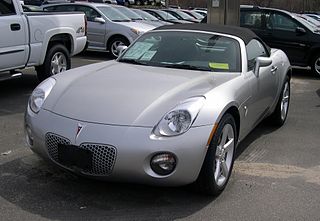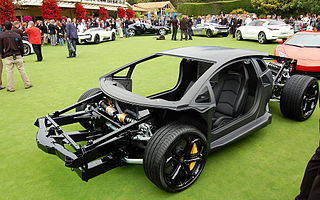General Motors has used the X-platform or X-body designation for two different automobile platforms. All X-bodies were compact car models.
- 1962–1979 General Motors X platform (RWD)
- 1980–1985 General Motors X platform (FWD)
General Motors has used the X-platform or X-body designation for two different automobile platforms. All X-bodies were compact car models.

LaSalle was an American brand of luxury automobiles manufactured and marketed, as a separate brand, by General Motors' Cadillac division from 1927 through 1940. Alfred P. Sloan, GM's Chairman of the Board, developed the concept for four new GM marques - LaSalle, Marquette, Viking and Pontiac - paired with already established brands to fill price gaps he perceived in the General Motors product portfolio. Sloan created LaSalle as a companion marque for Cadillac. LaSalle automobiles were manufactured by Cadillac, but were priced lower than Cadillac-branded automobiles, were shorter, and were marketed as the second-most prestigious marque in the General Motors portfolio. LaSalles were titled as LaSalles, and not as Cadillacs. Like Cadillac — named after Antoine de la Mothe Cadillac — the LaSalle brand name was based on that of another French explorer, René-Robert Cavelier, Sieur de La Salle.

The Chevrolet Celebrity is a mid-size automobile that was manufactured and marketed by the Chevrolet division of General Motors for model years 1982-1990. Replacing the Malibu, the Celebrity was initially marketed between the Citation and the Impala within the Chevrolet model line, eventually marketed between the Corsica and Caprice sedans.
A general assembly or general meeting is a meeting of all the members of an organization or shareholders of a company.

In the automotive industry, rebadging is a form of market segmentation used by automobile manufacturers around the world. To allow for product differentiation without designing or engineering a new model or brand, a manufacturer creates a distinct automobile by applying a new "badge" or trademark to an existing product line.

A car platform is a shared set of common design, engineering, and production efforts, as well as major components, over a number of outwardly distinct models and even types of cars, often from different, but somewhat related, marques. It is practiced in the automotive industry to reduce the costs associated with the development of products by basing those products on a smaller number of platforms. This further allows companies to create distinct models from a design perspective on similar underpinnings. A car platform is not to be confused with a platform chassis, although such a chassis can be part of an automobile’s design platform, as noted below.
The H platform, or H-body, refers to two different automobile platforms produced by General Motors. The 1970s H-body was rear-wheel drive and used for the compact Chevrolet Vega and Monza, and their Buick, Oldsmobile, and Pontiac derivatives. The 1980s H-body was a front-wheel drive full-size car platform, and was the basis for GM's second generation downsized full-size cars, which included the Buick LeSabre, Oldsmobile 88, and Pontiac Bonneville.
The V platform, or V-body, automobile platform designation was used twice by General Motors.
The General Motors G platform designation was used for three different automobile platforms.
The General Motors A platform was an automobile platform, and was GM's original, and oldest, platform used by all early GM products, beginning with the Chevrolet Superior. From this platform, all North American platforms B, C, and D were developed.

Kappa was General Motors' subcompact rear-wheel drive automobile platform for roadster applications. The architecture debuted in the 2006 Pontiac Solstice and 2007 Saturn Sky, and ended production in 2009. These vehicles generally have a "M" in the fourth digit of their VIN.
The T platform, or T-body, can refer to two different automobile platforms produced by General Motors, both used for subcompact cars.
The C platform, or C-body, name has been used twice by General Motors for its full-size car platform.

The General Motors N platform was a front-wheel drive compact automotive platform produced from 1984 to 2005. The GM N platform was based on the GM J-Body and replaced the GM X platform.

A subframe is a structural component of a vehicle, such as an automobile or an aircraft, that uses a discrete, separate structure within a larger body-on-frame or unit body to carry certain components, such as the engine, drivetrain, or suspension. The subframe is bolted and/or welded to the vehicle. When bolted, it is sometimes equipped with rubber bushings or springs to dampen vibration.

The General Motors A platform was a mid-size platform designation used from 1982-1996. Previously the A body designation had been used for rear wheel drive mid-sized cars. They were initially offered alongside, but eventually supplanted rear-drive nameplates such as the Malibu for the intermediate class. Due to the strong popularity of the older rear wheel drive design, General Motors continued their production as the G-Body until 1988.
The A platform is a term most commonly associated with automobile body type and has several meanings:
In the context of the automobile industry, downsizing is a practice used to transition vehicles from one size segment to another. Commenced during the Malaise era, downsizing is done in response to consumer and government demands influencing vehicle design. As vehicle product lines completed their model cycles, automobile manufacturers developed the next generation of a vehicle with a smaller exterior footprint to allow for weight reduction and increased fuel economy, using a shortened wheelbase and body length.

The General Motors X platform is an automobile platform designation that was used for compact cars with rear-wheel drive. Developed by Chevrolet, the architecture was produced from the 1962 to 1979 model years. During the 1970s, the platform was used by multiple GM divisions as the company expanded its use of compact model lines.

The Jeep Wagoneer is a sport utility vehicle (SUV) nameplate of Jeep vehicles, with several models marketed for the 1963 through 1993 model years and again since the 2022 model year.